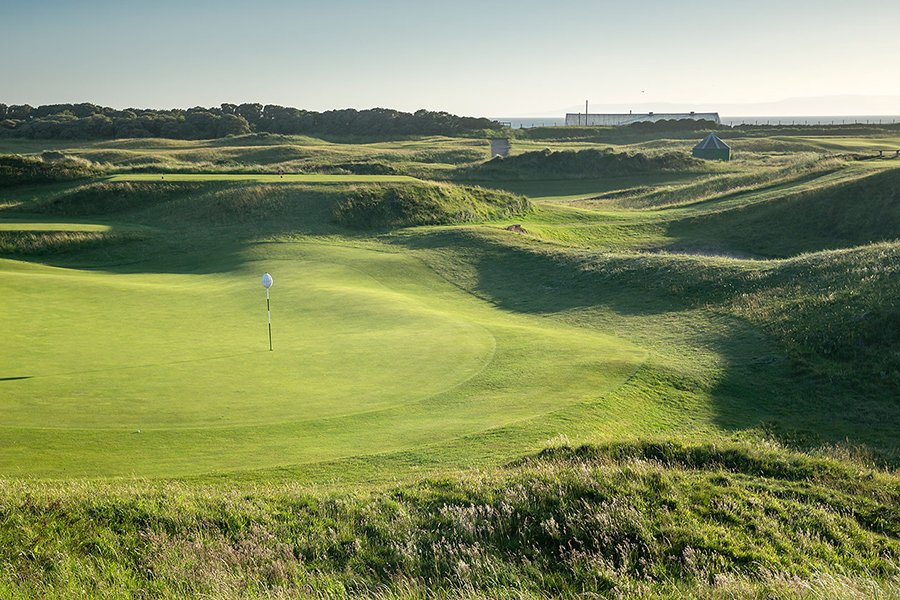The Original 12 - Prestwick
5 MIN READ
PHOTOGRAPHY - MARK ALEXANDER
Prestwick Golf Club was founded in 1851 and is one of the oldest golf clubs in the world. Golf had been played on the land bordering the Ayrshire town of Prestwick for many years but no formal golf course existed. On 2nd July 1851, 57 gentlemen met in the Red Lion Inn in Prestwick and agreed to form a golf club with the 13th Earl of Eglinton as the first Captain.
The driving force behind the creation of the Club was James Ogilvie Fairlie. He had been the Captain of the R&A in 1850 and often played with Tom Morris in St Andrews. Fairlie persuaded Morris to come to Prestwick to be the Keeper of the Green and Club and Ball Maker to the newly formed club.
10th green on original layout, 15th as you play it today.
Morris’ first task on arriving at Prestwick was to lay out a golf course. He had previously assisted Allan Robertson with changes to the links at Carnoustie, but Prestwick was his first opportunity to lay out a course on his own. Not having access to the type of earthmoving equipment commonplace today, Morris’ approach to golf course design was to identify good places to site the greens. It is said that he would wander round the land and mark the site of greens with feathers to remind himself to prepare a green there. His route criss-crossed and the resultant 12-hole course was a mixture of shots over sand dunes, humps and hollows. He believed it was up to the golfer to negotiate the challenge he had set them – where a sand dune was between the player and his target he had the choice of going over or round the obstacle depending on his skill level.
The original site of the 1st tee
Prestwick Golf Club is famous as the Birthplace of the Open. In the 1850s the best golfer of the time was Allan Robertson of St Andrews. Known as the Champion Golfer of Scotland, Robertson was the first player to score less than 80 on the Old Course and it is said that he never lost a money match playing his own ball or with Morris as his partner. Robertson had a business in St Andrews making featherie golf balls and Tom Morris was apprenticed to him for a while. Their ways parted when Morris used one of the new gutta percha balls which Robertson saw as a threat to his trade. This gave Morris the opportunity to come to Prestwick in 1851. Allan Robertson died in 1859 which then begged the question who was now the best golfer?
Alps hole 2, 17th hole as you play it today
More for the entertainment of and to satisfy the curiosity of the Prestwick members it was agreed to invite clubs to send their best and most reputable caddies to take part in a competition at the Club. As the caddies tended to follow their gentlemen around the various competitions and matches they played in it was agreed to hold the event the day after the Prestwick Golf Club Autumn Medal as most of the leading amateur players would be taking part in that competition.
On Wednesday 17 October 1860, eight golfers teed it up in that first Open.
The 10th green in 1851
Over the years the Club has occasionally recreated Tom Morris’ 12-hole course – the last time being in 2005. Previous efforts have always been rudimentary but advances in available equipment and greenkeeping practices gave the opportunity this time to produce a better standard of links. The 150th Open due to be played at St Andrews in 2021 gave the opportunity for the Club to celebrate this milestone in the event and it was agreed that the 12-hole course should be a feature of their celebrations.
Planning started in 2020 when it was anticipated that the 150th Open would be held in 2021. Plans were delayed by the Covid pandemic, but this allowed more time to research and plan for the re-creation. Six of the original greens were still in use at the 2nd, 3rd, 13th, 15th 16th and 17th holes on the 18-hole course. With one exception, the other greens were on fairway and with some care and attention could be brought back to a suitable condition for putting. The green of the 7th hole was in an area of rough which could not be easily reclaimed so the rough was removed and new turf laid down.
Red flag - 7th green, White flag 10th green (15th as you play it today)
The most challenging aspect of restoring the 12-hole course was trying to reclaim the fairways of the 1st/12th and 6th holes. Over the years these areas had not been in play on the 18-hole course so were a mixture of high rough and marram grass.
Under the leadership of Head Greenkeeper, Dave Edmondson, the team addressed the challenge with relish. Modern rough cutting equipment certainly helped in the task.
The club has many days of celebration in the next week or so with members, guest and visitors from all over the world coming to experience the original hole layout before the course is once again laid to rest.






